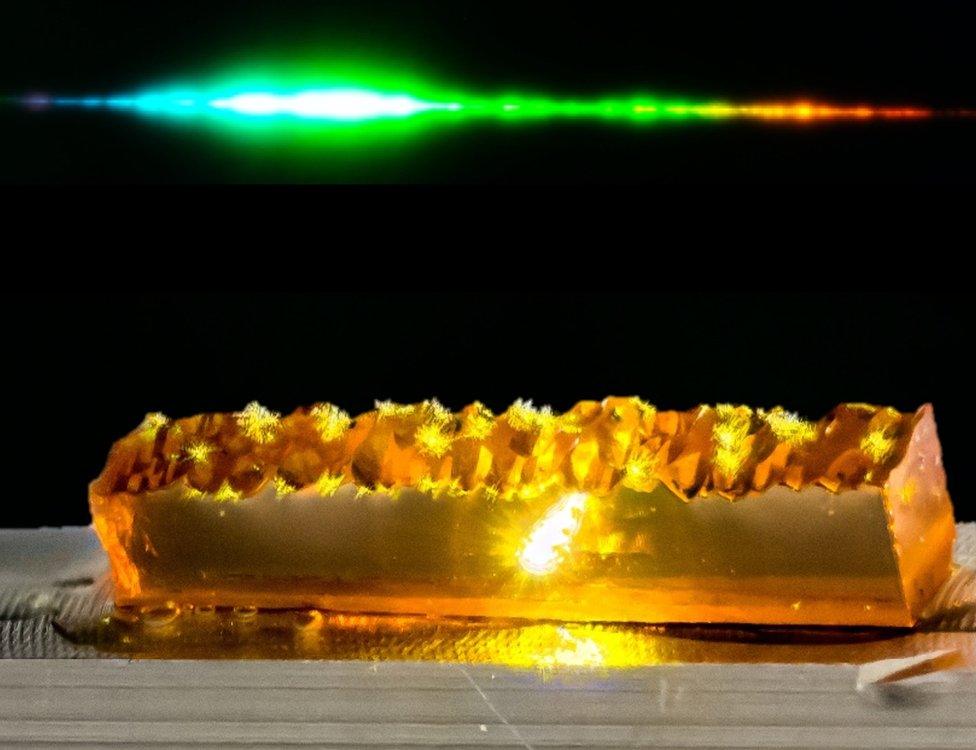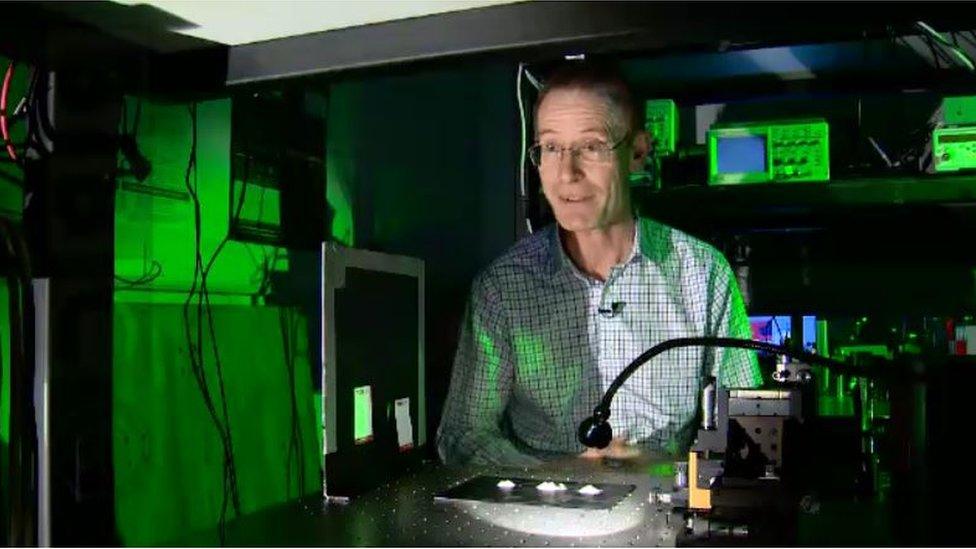Researchers create the Jimi Hendrix of lasers
- Published

Jimi Hendrix was famous for his distorted guitar sound
Photonics experts at Heriot-Watt university are hailing a breakthrough in laser research.
They have come up with a new and relatively inexpensive way of creating a laser supercontinuum.
They hope it could eventually have applications in bio-imaging and optical communications.
What is a Supercontinuum?
Generation of a supercontinuum happens when intense laser light of a single colour travels through a material and then broadens into a spectrum of colours.
This might at first seem a bit like splitting white light into a rainbow of colours via a prism.
However, in a supercontinuum each colour retains the tight and precise qualities of laser light when it is separated.

Supercontinuum generation from the specially engineered gallium phosphide crystal
The team at Heriot-Watt's Institute of Photonics and Quantum Sciences was led by Prof Derryck Reid, who says if you want to understand the phenomenon it helps to think of Jimi Hendrix.
"If I take my electric guitar, plug it into a high gain amplifier and just pluck the string gently, I'll hear a pure note," he says.
"But if I hit the string harder I'm going to get the classic Jimi Hendrix distortion, when the amplifier adds harmonics of the original sound on to the output.
"There's an equivalent effect with light, where an intense laser beam generates new colours as it travels through a material."

A normal dispersive prism can be used to break white light up into its constituent spectral colours (the colours of the rainbow)
Until now scientists could generate a supercontinuum in one of two ways.
They could use a special optical fibre only about one-tenth the width of a human hair. This would concentrate the light to a very high intensity over lengths of a few metres.
Or they could use an even more powerful light beam from an amplified laser and tightly focus it onto ordinary glass.
These existing methods can be bulky, costly and extremely fiddly.
Prof Reid says the new method represents the best of both worlds: a colourful supercontinuum from a bulk material using lower-power lasers.
"If we took just a low power laser and focused it into a normal piece of glass, we wouldn't see anything exciting - no additional colours generated," he says.
"But we've switched out the glass for a special crystal of a material called gallium phosphide.
"So if I go back to my guitar analogy that's like switching on the amplifier and turning it up to 11."

Prof Derryck Reid led the team involved
Prof Reid said gallium phosphide was "very high gain nonlinear crystal" so even with a low-power laser and a simple lens it can produce a wide spectrum of colours.
The specially engineered crystal creates a cascade effect.
"When we send our infrared laser into the crystal we produce a little bit of green light," Prof Reid says.
"That then kicks off a cascade effect where the green light generates a bit more green light at a longer wavelength that becomes first yellow, then orange, then red, and that builds up to form this supercontinuum, a kind of rainbow of colours.
"The weaker edges of the light can generate green at longer and longer wavelengths. This has never been reported before."
It sounds good and looks beautiful. But beyond driving back the frontiers of knowledge, is it of any practical use?
"In one sense this is a fundamental discovery," Prof Reid says.
"We do indeed have to increase the output power from this technique before it can be used practically.
"But if we can do that the applications are in things like life sciences imaging - fluorescent microscopy, where biologists take lasers of different colours and use them to excite fluorescent cells and identify different parts of the cell structure."

Like Spinal Tap, the aim is to turn it up to 11
Other potential uses are in the fields of optical communications and fundamental studies of materials.
The research has been published in the scientific journal Optica.
Prof Reid and his team are now trying to make the laser spectrum more intense by optimising the properties of the crystal.
So - to conflate the Hendrix analogy with Spinal Tap - there are hopes the technique can be amplified further, perhaps even turning it up beyond 11.